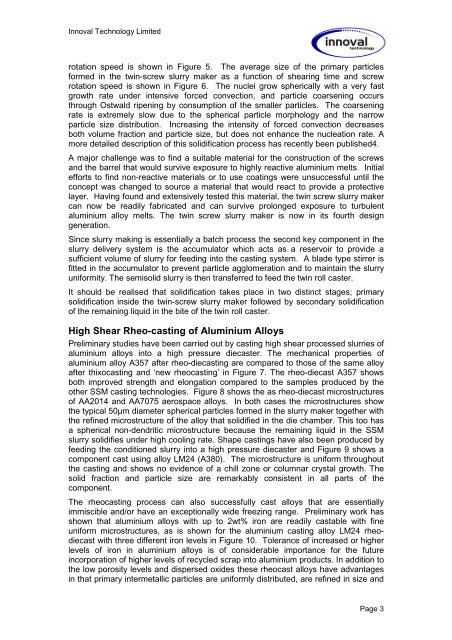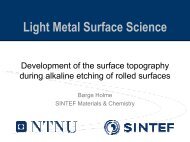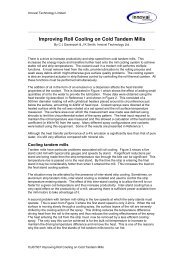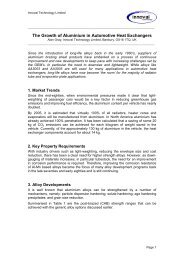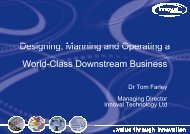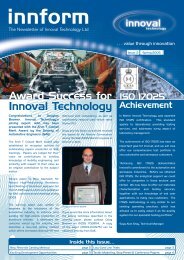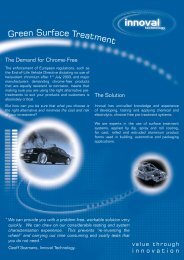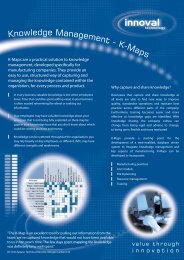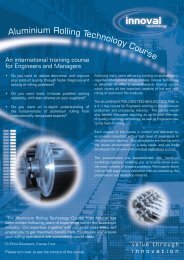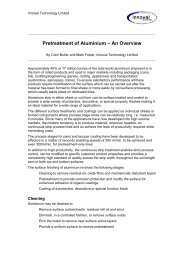Twin Roll Rheocasting of Aluminium Alloys - Innoval Technology Ltd
Twin Roll Rheocasting of Aluminium Alloys - Innoval Technology Ltd
Twin Roll Rheocasting of Aluminium Alloys - Innoval Technology Ltd
You also want an ePaper? Increase the reach of your titles
YUMPU automatically turns print PDFs into web optimized ePapers that Google loves.
<strong>Innoval</strong> <strong>Technology</strong> Limited<br />
rotation speed is shown in Figure 5. The average size <strong>of</strong> the primary particles<br />
formed in the twin-screw slurry maker as a function <strong>of</strong> shearing time and screw<br />
rotation speed is shown in Figure 6. The nuclei grow spherically with a very fast<br />
growth rate under intensive forced convection, and particle coarsening occurs<br />
through Ostwald ripening by consumption <strong>of</strong> the smaller particles. The coarsening<br />
rate is extremely slow due to the spherical particle morphology and the narrow<br />
particle size distribution. Increasing the intensity <strong>of</strong> forced convection decreases<br />
both volume fraction and particle size, but does not enhance the nucleation rate. A<br />
more detailed description <strong>of</strong> this solidification process has recently been published4.<br />
A major challenge was to find a suitable material for the construction <strong>of</strong> the screws<br />
and the barrel that would survive exposure to highly reactive aluminium melts. Initial<br />
efforts to find non-reactive materials or to use coatings were unsuccessful until the<br />
concept was changed to source a material that would react to provide a protective<br />
layer. Having found and extensively tested this material, the twin screw slurry maker<br />
can now be readily fabricated and can survive prolonged exposure to turbulent<br />
aluminium alloy melts. The twin screw slurry maker is now in its fourth design<br />
generation.<br />
Since slurry making is essentially a batch process the second key component in the<br />
slurry delivery system is the accumulator which acts as a reservoir to provide a<br />
sufficient volume <strong>of</strong> slurry for feeding into the casting system. A blade type stirrer is<br />
fitted in the accumulator to prevent particle agglomeration and to maintain the slurry<br />
uniformity. The semisolid slurry is then transferred to feed the twin roll caster.<br />
It should be realised that solidification takes place in two distinct stages; primary<br />
solidification inside the twin-screw slurry maker followed by secondary solidification<br />
<strong>of</strong> the remaining liquid in the bite <strong>of</strong> the twin roll caster.<br />
High Shear Rheo-casting <strong>of</strong> <strong>Aluminium</strong> <strong>Alloys</strong><br />
Preliminary studies have been carried out by casting high shear processed slurries <strong>of</strong><br />
aluminium alloys into a high pressure diecaster. The mechanical properties <strong>of</strong><br />
aluminium alloy A357 after rheo-diecasting are compared to those <strong>of</strong> the same alloy<br />
after thixocasting and ‘new rheocasting’ in Figure 7. The rheo-diecast A357 shows<br />
both improved strength and elongation compared to the samples produced by the<br />
other SSM casting technologies. Figure 8 shows the as rheo-diecast microstructures<br />
<strong>of</strong> AA2014 and AA7075 aerospace alloys. In both cases the microstructures show<br />
the typical 50µm diameter spherical particles formed in the slurry maker together with<br />
the refined microstructure <strong>of</strong> the alloy that solidified in the die chamber. This too has<br />
a spherical non-dendritic microstructure because the remaining liquid in the SSM<br />
slurry solidifies under high cooling rate. Shape castings have also been produced by<br />
feeding the conditioned slurry into a high pressure diecaster and Figure 9 shows a<br />
component cast using alloy LM24 (A380). The microstructure is uniform throughout<br />
the casting and shows no evidence <strong>of</strong> a chill zone or columnar crystal growth. The<br />
solid fraction and particle size are remarkably consistent in all parts <strong>of</strong> the<br />
component.<br />
The rheocasting process can also successfully cast alloys that are essentially<br />
immiscible and/or have an exceptionally wide freezing range. Preliminary work has<br />
shown that aluminium alloys with up to 2wt% iron are readily castable with fine<br />
uniform microstructures, as is shown for the aluminium casting alloy LM24 rheodiecast<br />
with three different iron levels in Figure 10. Tolerance <strong>of</strong> increased or higher<br />
levels <strong>of</strong> iron in aluminium alloys is <strong>of</strong> considerable importance for the future<br />
incorporation <strong>of</strong> higher levels <strong>of</strong> recycled scrap into aluminium products. In addition to<br />
the low porosity levels and dispersed oxides these rheocast alloys have advantages<br />
in that primary intermetallic particles are uniformly distributed, are refined in size and<br />
Page 3


